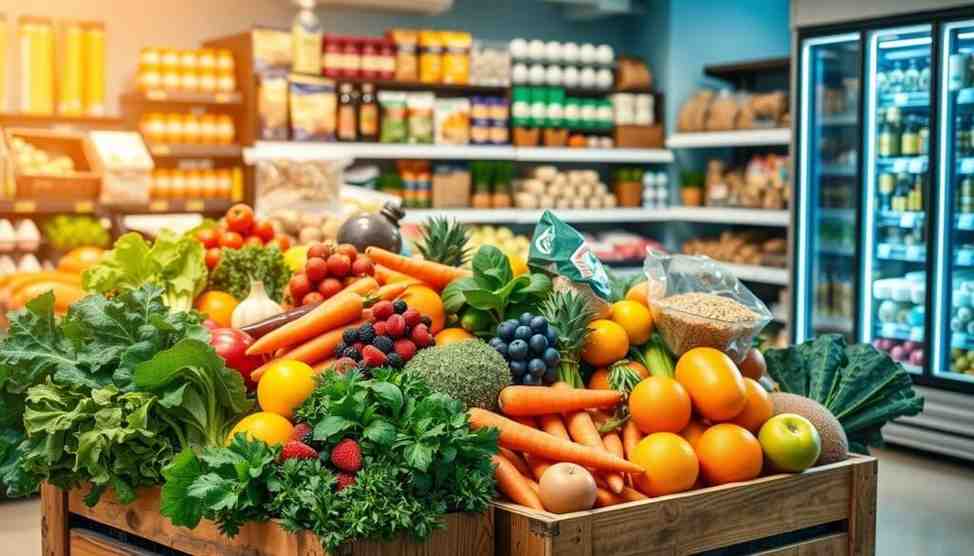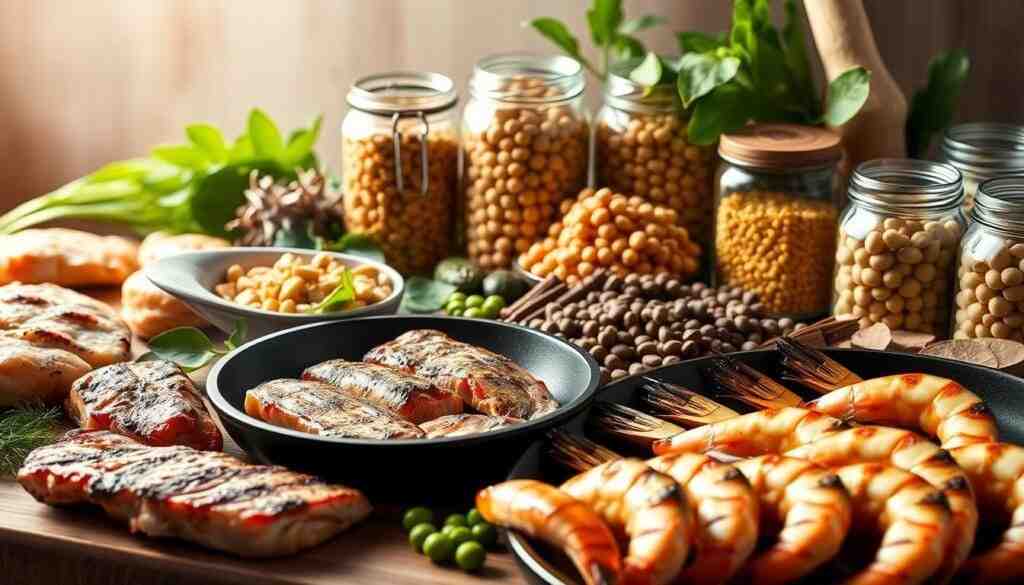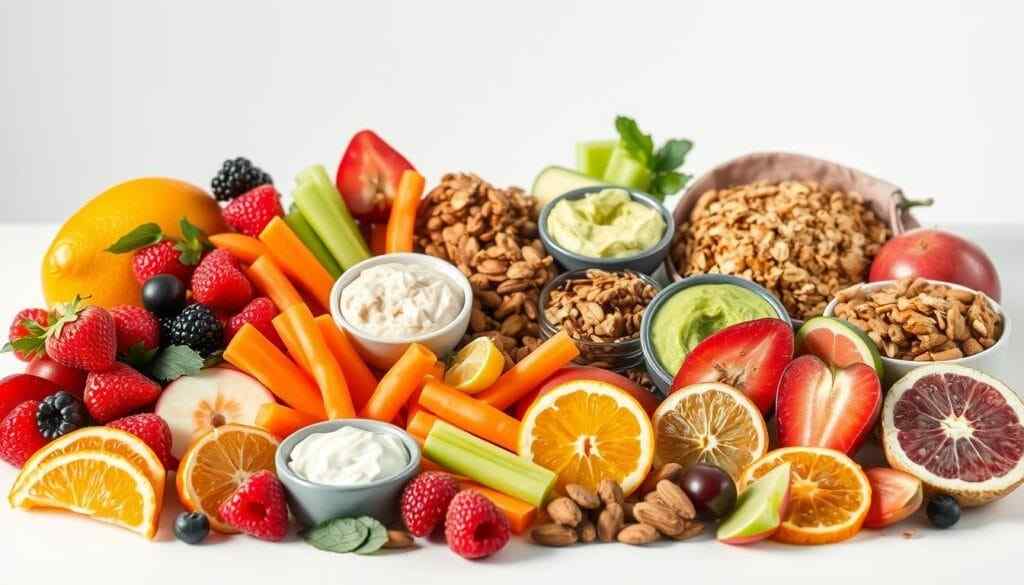Healthy Eating Grocery List, Imagine having a grocery list that helps you shop smart, saves money, and cuts down on food waste. A well-planned list lets you follow your healthy eating plan and reach your nutrition goals. It’s key for meal planning and clean eating, helping you choose the right foods.

By planning your shopping, you can pick the right foods and avoid unhealthy ones. Your list should have lots of whole foods like fruits, veggies, whole grains, and lean proteins. With some planning, you can make a list that’s good for you and your family, making shopping for meals easy.
Key Takeaways
- A healthy eating grocery list can help you make smart shopping choices and stick to your healthy eating plan.
- Planning ahead is key to creating a list with lots of whole foods.
- Include foods high in fiber and low in sugar, like whole grains and fresh fruits and veggies.
- Lean proteins, like skinless chicken and turkey, are great for your list.
- Shopping the store’s edges helps you find whole foods and avoid processed items.
- A healthy list can save you money and reduce waste by avoiding bad purchases.
Understanding the Basics of a Healthy Eating Grocery List
Having a well-planned grocery list is key for healthy eating. Studies show that using a food shopping list leads to better eating habits. Planning meals and making a list can save you about 20% on groceries. It also cuts down food waste by up to 30%.
A good grocery list should have nutrient-dense foods like whole grains, lean proteins, and lots of fruits and veggies. Meal planning is important to make the most of your list. It helps avoid buying things you don’t need.
Some essential items for a balanced list are:
- Whole grains, such as brown rice, quinoa, and whole wheat bread
- Lean proteins, like chicken, fish, and tofu
- A variety of fruits and vegetables, including seasonal produce
Learning about a healthy grocery list and adding nutrient-dense foods and whole grains to your meal planning helps. It leads to better eating habits and less food waste.
Smart Shopping Strategies for Nutritious Foods
Shopping for budget-friendly healthy foods requires planning. Studies show that planning meals can cut grocery bills by up to 25%. Make a list and stick to it to avoid impulse buys. Shopping on an empty stomach can lead to 30% more impulse purchases.
Shop the store’s perimeter for fresh produce, meats, and dairy. About 70% of items are in the interior aisles, filled with processed foods. Choose seasonal organic produce selection for better prices. Summer brings zucchini, berries, and peaches, while fall offers sweet potatoes, apples, and pumpkins.
Here are more tips for smart shopping:
- Buy staples like brown rice, lentils, and canned goods in bulk to save money.
- Opt for store-brand items for big savings.
- Visit discount stores like Aldi or Costco.
- Use cashback apps or digital coupons to earn rewards.
By using these strategies, healthy eating can be more affordable. Always check labels and look for the Heart-Check mark. It ensures the product meets nutritional standards. With planning and creativity, you can enjoy budget-friendly healthy foods and organic produce selection without spending too much.
Fresh Produce Selection Guide
Choosing fresh produce is key to getting the best quality for your money. A good organic produce selection brings you essential nutrients. Start by picking seasonal fruits and veggies. They are fresher and taste better.
Look for produce that’s firm, bright in color, and without bruises. Also, think about whole grains shopping. Choose items high in fiber and nutrients. Apples and bananas are full of fiber. Spinach and kale are packed with vitamins and minerals.
- Wash all produce under hot running water before consumption
- Store fruits and vegetables in a cool, dry place to maintain freshness
- Keep raw meat separate from fresh produce to prevent cross-contamination
By following these tips, you can stock up on nutritious produce. Always prioritize food safety and handle your produce with care. This way, you’ll get the most from your organic produce selection and whole grains shopping experience.
Protein Sources for Your Shopping Cart
Incorporating a variety of lean proteins is key to a healthy diet. You can find these in animal-based foods like chicken, fish, and dairy. Plant-based options include legumes, beans, and nuts. Aim for 10 to 15 grams of protein in snacks and up to 30 grams in meals to support muscle growth and repair.
High-protein foods include Greek yogurt with 20 grams per cup. Lean meats like chicken and turkey have 25 grams per 4 ounces. Plant-based foods like lentils and chickpeas are also high in protein, with 18 grams and 15 grams per cup, respectively.

For healthy snacks choices, nuts like almonds and pistachios are great. They offer 6 grams and 12 grams of protein per ounce. Seeds like chia and hemp are also good, with 5 grams and 10 grams per ounce. Adding these protein-rich foods to your diet supports overall health and well-being.
Here are some more high-protein foods to consider:
- Black beans: 8 grams of protein per cup
- Quinoa: 8 grams of protein per cup
- Salmon: 20 grams of protein per 3.5 ounces
- Tofu: 9 grams of protein per 3 ounces
Whole Grains and Healthy Carbohydrates
When shopping for whole grains, aim for the best nutritional value. Healthy carbs are key for energy and health. Grains like brown rice, quinoa, and whole wheat are packed with fiber, vitamins, and minerals.
They help lower cholesterol, control blood sugar, and support weight management.
Consider ancient grains like Kamut, spelt, and bulgur. They’re rich in fiber and protein. This makes them a smart choice for your shopping list. Always check labels for hidden sugars and artificial ingredients. Choose products with less added sugar and natural ingredients.
Here are some tips for adding whole grains to your diet:
- Choose whole grain bread and pasta over refined ones
- Try new grains like quinoa, farro, and bulgur
- Experiment with different whole grain flours, such as almond and coconut flour
Some top picks for bread and pasta are:
| Bread | Pasta |
|---|---|
| Ezekiel 4:9 Sprouted Whole Grain Bread | Banza Chickpea Pasta |
| Alvarado Street Bakery Whole Grain Bread | Barilla Whole Grain Spaghetti |
Whole grains shopping is about making smart choices. By choosing healthy carbs and whole grains, you boost your health. So, next time you’re shopping, look for whole grain options and make better choices.
Building Your Healthy Snack Arsenal
Planning ahead is key for healthy snacks choices. A well-stocked pantry with nutritious options helps everyone make better choices. Use a grocery list template to organize your shopping and remember important items.
A good snack arsenal has whole grains, protein, healthy fats, and fruits or veggies. Try Three Wishes Grain Free Cereal, 2Betties mini baked donuts, and AMARA Organic Fruit Bites. Making your own snacks at home with yogurt, nuts, and seeds is also a great idea.
Here are some tips for building your healthy snack arsenal:
- Shop the produce section first to ensure you’re getting plenty of fruits and vegetables
- Choose whole grains over refined grains whenever possible
- Opt for nuts and seeds as a healthy source of protein and healthy fats
By following these tips and using a grocery list template, you can create a healthy snack arsenal. This will keep you and your family fueled and focused all day. Always choose healthy snacks choices that are low in added sugars and high in nutrients.

Budget-Friendly Healthy Food Options
When planning meals, it’s key to look for affordable healthy foods. The average American spends about 11.3% of their income on food. Finding ways to save without losing nutrition is important. Using seasonal produce can save 20-50% compared to out-of-season foods.
Also, try store brand alternatives for savings of 20-25% over name brands. Bulk buying can cut costs by 10-30% for larger items. These strategies help make a healthy food plan that’s easy on your wallet.
Some cheap yet nutritious meals include:
- Tomato Bun Tuna Melt, costing around $1.82 per serving
- Vegetarian Spaghetti Squash Lasagna, priced at $2.91 per serving
- Easy Chicken Fried Rice, available for $1.53 per serving
Adding these affordable healthy foods to your meals lets you eat well without overspending. Don’t forget the value of meal planning and budget-friendly healthy foods in your healthy eating journey.
Good meal planning can save up to 30% on grocery bills. Using grocery lists can also stop impulse buys, which make up 20-30% of spending. Being smart about food costs helps you make a healthy, affordable eating plan.
Creating Your Weekly Meal Plan
Meal planning is key to a healthy diet. First, think about what you want to achieve. Do you aim for clean eating or controlling calories? A good meal plan helps you reach your goals. Start by setting a calorie goal that fits your lifestyle and nutritional needs.
Start with a clean eating shopping list. Choose whole foods like fruits, veggies, lean proteins, and grains. Try to have different colors on your plate for a variety of nutrients. Meal prepping can also save time and cut down on waste.
- Plan meals around fresh, seasonal produce for variety and freshness
- Include protein at every meal for fullness and energy
- Drink plenty of water to stay hydrated
By following these tips, you can make healthy eating a lasting habit. Be open to changes as your needs and tastes evolve. This way, your clean eating shopping list will always be up to date.
Healthy Pantry Staples List
Having a well-stocked pantry is key to a healthy diet. A list of healthy pantry staples can make meal prep easier and save time. With a grocery list template, your pantry will always have what you need.
A good pantry includes whole grains, plant-based proteins, and healthy fats. Some must-haves are:
- Quinoa and brown rice
- Canned beans and tomatoes
- Nut butters and avocado oil
- Herbs and spices
These items help you make balanced meals and cut down on waste. Meal planning can even reduce food waste by 20%. A healthy pantry list and a grocery template make cooking simpler and improve your diet.
Adding healthy pantry staples to your diet boosts your health. Whole grains increase fiber by 25%, and healthy fats help you feel full and eat fewer calories. With planning and a stocked pantry, you can make tasty, nutritious meals that keep you satisfied.
Conclusion: Making Your Healthy Shopping List a Lifestyle
Congratulations on starting your journey to a healthier lifestyle with a personalized grocery list. This is just the beginning of a path toward better meal planning and nutrition. The goal is to make healthy shopping and eating a regular part of your life.
Start by adding whole grains, lean proteins, fresh fruits and veggies, and healthy fats to your shopping list. Plan your meals ahead of time and try new, nutritious foods. Slowly change your diet to let your taste buds and body get used to it.
Keep going by thinking about the long-term benefits of a balanced diet. You’ll feel more energetic, manage your weight better, and lower your risk of serious diseases. Celebrate every small win and don’t get down about setbacks. With time and effort, eating healthy can become second nature.
FAQ
What are the key components of a balanced healthy eating grocery list?
A balanced list should have whole grains, lean proteins, and healthy fats. It should also include fresh fruits, vegetables, and low-fat dairy products.
Why is planning ahead and creating a grocery list important?
Planning ahead and making a list helps reduce waste and save money. It ensures you have what you need to make healthy meals.
What are some smart shopping strategies for purchasing nutritious foods on a budget?
Smart strategies include buying in bulk and choosing seasonal produce. Opting for store brands can also save money without sacrificing quality.
How can I select the best fresh produce for my healthy eating grocery list?
Choose seasonal fruits and vegetables for the best taste and value. Aim for a variety of colors and understand the differences between organic and conventional produce.
What are the best protein sources to include on a healthy eating grocery list?
Include lean meats, poultry, fish, eggs, legumes, and nuts. These are great protein sources for a healthy diet.
How can I ensure I’m purchasing whole grains and healthy carbohydrates?
Read labels to avoid hidden sugars. Look for whole wheat bread, whole grain pasta, and ancient grains.
What are some healthy snack ideas to include on my grocery list?
Healthy snacks can be fresh fruits, vegetables, nuts, seeds, yogurt, and whole grain crackers or bars.
How can I create a budget-friendly healthy eating grocery list?
To save money, buy seasonal produce and look for store brands. Buying in bulk is also a good strategy.
How do I create an effective weekly meal plan based on my healthy eating grocery list?
Plan meals around your schedule and use leftovers. Make a list based on the ingredients you need for your meals.
What are some essential healthy pantry staples to keep on hand?
Keep whole grains, canned and dried beans, nuts, seeds, olive oil, spices, and herbs in your pantry. These are key for healthy cooking.




